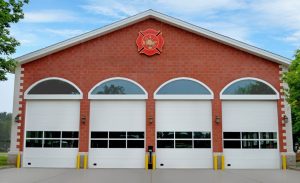The installation of fire station doors is a critical component of fire station infrastructure. This guide outlines essential safety guidelines for the installation process employed by fire station door suppliers, emphasizing the importance of ensuring the security and functionality of these vital access points.
Understanding the Significance of Fire Station Doors:
fire station door suppliers are integral to the efficient and effective operation of fire stations. They must meet stringent safety and operational requirements to ensure rapid response to emergencies and the security of valuable equipment and personnel.

Guidelines for Installation:
- Compliance with Safety Standards:
Fire station door suppliers must adhere to industry safety standards and local building codes when designing and installing doors. Compliance ensures that doors meet safety and security requirements.
- Proper Sizing and Clearances:
Suppliers must accurately measure the door opening to ensure the door fits correctly. Proper clearances around the door are essential to prevent obstructions and facilitate smooth operation.
- Fire-Rated Doors:
Fire station doors are often required to be fire-rated. Suppliers should install fire-rated doors in accordance with manufacturer specifications to maintain their integrity in case of a fire.
- Robust Security Features:
Fire station doors often incorporate advanced security features, including electronic access control, alarms, and tamper-resistant locking mechanisms. These features must be installed and tested for functionality.
- Emergency Release Mechanisms:
Suppliers should ensure that emergency release mechanisms, which allow for manual operation in case of power failure or emergencies, are installed correctly and are easily accessible.
- Weatherproofing and Insulation:
Fire station doors must provide weatherproofing to prevent moisture infiltration. Insulation is also crucial to maintain a stable indoor temperature and energy efficiency.
- Regular Maintenance Checks:
Suppliers should offer guidance on routine maintenance checks for fire station doors. Routine inspections help identify and address issues promptly, ensuring door functionality.
- Training and User Manuals:
Suppliers should provide training to fire station personnel on operating and maintaining the doors. User manuals with clear instructions should be readily available.
- Timely Installation:
Suppliers must complete the installation process within the agreed-upon timeframe, minimizing disruptions to fire station operations.
- Emergency Response Drills:
– Suppliers should collaborate with fire station personnel to conduct emergency response drills involving the doors. This practice ensures that firefighters are familiar with door operation in high-pressure situations.
Conclusion:
The installation of fire station doors is a critical safety concern for both suppliers and fire station personnel. Adhering to these guidelines ensures that fire station doors are not only functional and secure but also capable of facilitating rapid response during emergencies. Fire station door suppliers play a pivotal role in safeguarding the lives and property of the community, making safety a top priority in every aspect of installation and operation.


